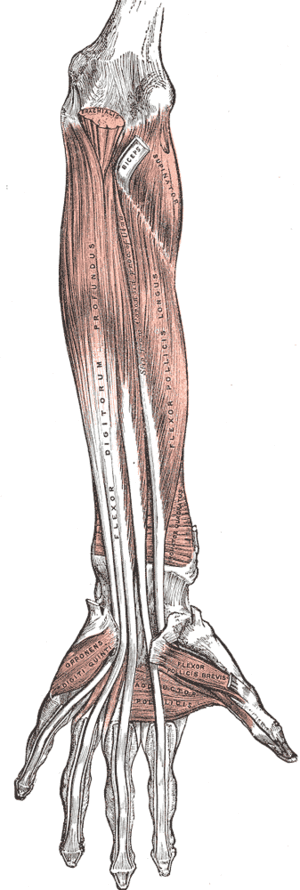Jersey Finger
Top Contributors - Shreya Pavaskar, Niha Mulla, Uchechukwu Chukwuemeka and Leana Louw
Description[edit | edit source]
Jersey finger (rugby finger) is an avulsion of the flexor digitorium profundus tendon (FDP) from its distal insertion on the distal phalanx (zone I). The ring finger is most commonly affected. Since the ring finger protrudes the farthest in the grasping position, it is more susceptible to FDP avulsion causing an inability to flex at the DIPJ.
Clinically Relevant Anatomy[edit | edit source]
FDP is one of the deep muscles of the anterior compartment of the forearm. It is the hybrid muscle supplied by two different nerves: medial half is supplied by ulnar nerve and lateral nerve is supplied by anterior interosseus nerve. It is the chief gripping muscle when the wrist is extended. It is the sole flexors of Distal Interphalangeal (DIP) Joint of digit 2nd to 5th.
Mechanism of Injury[edit | edit source]
Majority of injuries occur in ring finger at the point of insertion which is the weakest point in the tendon. An injury occurs to the finger if it is caught in the jersey of a player while the little finger continues to flex and extension of FDP occurs as the tackled player runs away. A forceful extension while contraction of FDP leads to avulsion of the tendon.
Clinical Presentation[edit | edit source]
- Inability to flex DIP joint.
- Pain, ecchymosis and oedema may be present
The classification system of a jersey finger injury is based on the level of tendon retraction and the presence or absence of a fracture. Types I-III were first described by Leddy and Packer in 1977, and two additional types, IV and V, have since been added.
- Type I: FDP tendon retracts to the palm at the lumbrical origin.
- Type II: FDP tendon retracts to the A3 pulley at the proximal interphalangeal (PIP) joint.
- Type III: Avulsion of a large bony fragment. Both FDP tendon and fracture fragment retract to the A4 pulley, as the bone fragment limits further retraction.
- Type IV: Avulsion of a large bony fragment with an accompanying rupture of the FDP tendon off the bony fragment. Since the avulsed FDP is not attached to the bony fragment, the FDP retracts into the palm.
- Type V: Avulsion of a large bony fragment, accompanied by another significant fracture of the distal phalanx.
Diagnostic Procedures[edit | edit source]
Physical examination along with X-rays and Ultrasound to rule out fractures is important. MRI can help in detailed evaluation of the injury and may help in identifying the extent of tendon retraction however it is rarely used.
Outcome Measures[edit | edit source]
add links to outcome measures here (see Outcome Measures Database)
Management / Interventions[edit | edit source]
add text here relating to management approaches to the condition
Differential Diagnosis[edit | edit source]
add text here relating to the differential diagnosis of this condition
Resources[edit | edit source]
add appropriate resources here







